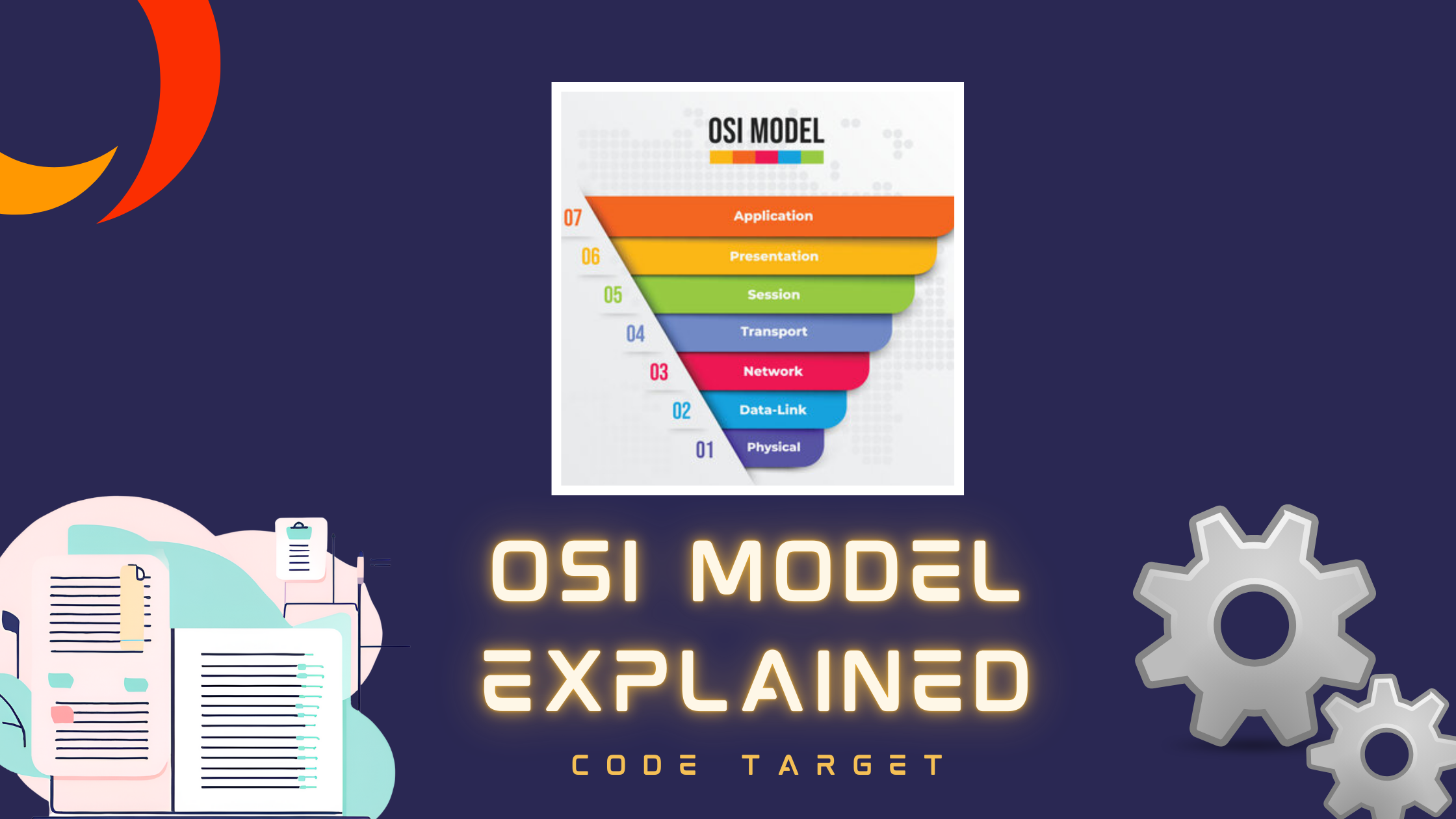Understanding the OSI Model: Complete Guide to the 7 Networking Layers
 Utkarsh Jha
Utkarsh Jha
Anyone interested in computer science, networking, or information technology must comprehend how data moves between devices in today's networked environment. The OSI Model, a framework that streamlines and standardizes network communication, is at the core of this comprehension. The OSI Model offers a clear road map for comprehending data transmission over networks by decomposing intricate processes into digestible layers. This guide will walk you through each of the seven layers, helping you grasp their unique roles and interconnections in the world of networking.
What is the OSI Model?
The International Organization for Standardization (ISO) created the OSI (Open Systems Interconnection) Model as a conceptual framework in the latter part of the 1970s. It makes it easier for different networking technologies and protocols to work together by standardizing a computing or telecommunications system's operations into seven different layers.

In order to create a coherent system for data transmission, each layer has a distinct function and communicates with the layers immediately above and below it. By clearly defining the roles and interactions of various components in a communication system, the OSI Model serves as a standardized framework for comprehending and designing network protocols and systems. This ensures interoperability across various technologies and enables developers to troubleshoot and implement networking solutions.
The Seven Layers of the OSI Model
1. Application Layer
Function: This is the topmost layer where end-user applications operate.
Purpose:
Facilitates direct user interaction with network services.
Provides interfaces and protocols that allow software applications to communicate over the network.
Protocols:
HTTP (Hypertext Transfer Protocol): Used for transferring web pages.
FTP (File Transfer Protocol): Used for transferring files between computers.
SMTP (Simple Mail Transfer Protocol): Used for sending emails.
Example: When you open a web browser and type a URL, the application layer processes your request and interacts with the web server.
2. Presentation Layer
Function: Acts as a translator between the application layer and the network.
Purpose:
Ensures that data is in a readable format for the application layer and translates it into a format suitable for transmission.
Handles issues of data encoding, compression, and encryption.
Key Activities:
Converts character sets (e.g., ASCII to EBCDIC).
Compresses data to reduce size for faster transmission.
Encrypts data for secure transmission (e.g., SSL/TLS).
Example: When you download a file, this layer might compress it for faster download and encrypt it for security.
3. Session Layer
Function: Manages sessions and controls dialogues between applications.
Purpose:
Establishes, maintains, and terminates connections (sessions) between applications.
Keeps track of who is talking and ensures that the conversation continues smoothly.
Key Activities:
Handles session establishment and termination (like logging in and out).
Synchronizes data exchange (e.g., checkpoints in long transfers).
Example: During a video conference, the session layer keeps the connection open and ensures both parties can communicate.
4. Transport Layer
Function: Ensures the reliable transmission of data across the network.
Purpose:
Provides error detection and correction to ensure data integrity.
Manages the flow of data to prevent overwhelming the network.
Key Activities:
Breaks down large data messages into smaller packets.
Assigns sequence numbers to packets for reassembly.
Implements flow control (using techniques like sliding windows).
Protocols:
TCP (Transmission Control Protocol): Guarantees delivery and order of packets.
UDP (User Datagram Protocol): Allows faster, connectionless transmission, suitable for applications like video streaming.
Example: When you stream a video, TCP ensures all parts of the video arrive in order, while UDP allows for quicker, less reliable updates.
5. Network Layer
Function: Manages the routing of data packets across networks.
Purpose:
Determines the best path for data to travel from the source to the destination.
Handles logical addressing, which uniquely identifies devices on the network.
Key Activities:
Routing packets through routers and switches based on IP addresses.
Fragmenting packets to fit the maximum transmission unit (MTU) of the network.
Protocols:
IP (Internet Protocol): Handles addressing and routing of packets.
ICMP (Internet Control Message Protocol): Used for error messages and operational queries.
Example: When you send an email, the network layer determines the optimal path the data takes to reach the recipient's mail server.
6. Data Link Layer
Function: Provides node-to-node data transfer and error correction.
Purpose:
Ensures reliable communication between devices on the same local network.
Handles physical addressing through MAC addresses.
Key Activities:
Encapsulates packets from the network layer into frames for transmission.
Detects and corrects errors that may occur during transmission.
Manages access to the physical medium (e.g., determining who can send data on a shared network).
Protocols:
Ethernet: Commonly used in wired local area networks (LANs).
Wi-Fi: Used for wireless local area networks.
Example: When your computer sends data over a local network, the data link layer ensures it gets to the correct device using MAC addresses.
7. Physical Layer
Function: Involves the physical medium for data transmission.
Purpose:
- Defines the physical characteristics of the network, including cables, switches, and electrical signals.
Key Activities:
Specifies how bits are transmitted over the physical medium (e.g., voltage levels, timing).
Defines the hardware standards and transmission rates (e.g., how fast data can be sent).
Example: When you connect a computer to a router using an Ethernet cable, this layer is responsible for transmitting the actual bits over that cable.
Concluding Thoughts
Understanding the OSI Model is essential for anyone venturing into the world of networking and telecommunications. By breaking down the complexities of network interactions into seven distinct layers, the OSI Model provides a structured approach to grasping how data is transmitted and received across diverse systems. Each layer plays a vital role, from the user-facing Application Layer to the fundamental Physical Layer that deals with the hardware.
As we navigate our increasingly connected world, a solid grasp of the OSI Model not only aids in troubleshooting and designing networks but also enhances our appreciation of the technology that underpins our daily communications. Whether you’re a student, a tech enthusiast, or a seasoned professional, mastering these concepts will empower you to understand and engage with the networking landscape more effectively.
As you continue your journey in networking, remember that each layer is interconnected, and together they create the seamless experiences we often take for granted. Embrace this foundational knowledge, and you’ll be well on your way to becoming proficient in the intricate world of network communications!
Got questions, tips, or personal experiences? Share them in the comments below, I’d love to hear from you! Dive into the comments, exchange insights, and let’s keep the conversation going.
Thank you for your time, and I look forward to sharing more insights with you soon.
Warm Regards,
Utkarsh Jha, Code Target
Subscribe to my newsletter
Read articles from Utkarsh Jha directly inside your inbox. Subscribe to the newsletter, and don't miss out.
Written by

Utkarsh Jha
Utkarsh Jha
Hey there! I'm Utkarsh, a passionate BTech Computer Science student specializing in AI and Data Science. As a versatile writer, my blog is your go-to space for in-depth insights into AI, LLMs, and cutting-edge technologies, as well as trends in finance, global markets, and geopolitics. Join me as I explore the latest innovations, share practical tips, and analyze the forces shaping our world. My goal is to demystify complex concepts and empower you to stay ahead in the fast-evolving landscape of technology and beyond. Let’s embark on this knowledge journey together and shape the future!